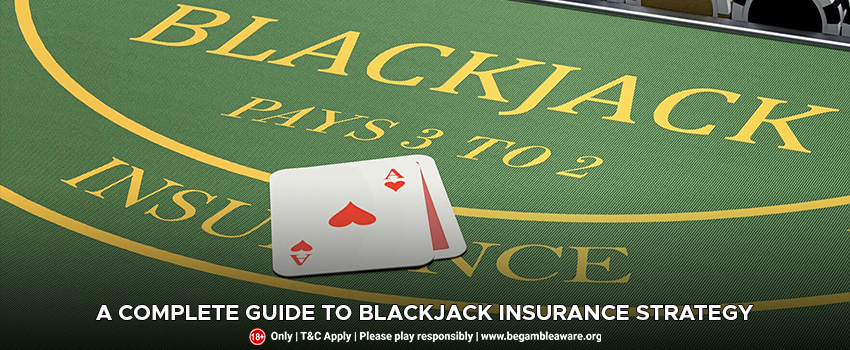A Complete Guide To Blackjack Insurance Strategy

Blackjack insurance has always been a source of prominence at the table regardless of whether it’s an element or the rules! However, how do you understand this type of bet, and when is the right time to utilize it?
In this guide, we’ll explore how insurance works in blackjack. Expose the numbers under the hood, and address the million-dollar issue – When should you consider taking insurance with blackjack? Let’s dive into the article.
What exactly is Blackjack insurance?
The Blackjack insurance wager is a side-betting feature. You can place the bet when the dealer can show his first card as an Ace. The side bet is placed in line with the initial bet made and is bet on the probability that the dealer hits Blackjack.
Payout is 2:1 when the bet succeeds. The primary goal of the insurance bet is to get back a portion of your initial bet if the dealer hits Blackjack.
What is the way that the insurance rule works in Blackjack?
In the case of Blackjack side betting, insurance stands out because of two reasons. Most side bets occur at the end of the game, which means you place bets on whatever you want.
In the case of insurance, it’s only available in a particular scene after the hand has started. In addition, you have to place a bet of a certain amount. Insurance does not appear or smell like a side bet; however, it is one. These are the three fundamental principles of insurance for blackjack:
- The dealer on the up-card must have an Ace
- It costs 50% of the initial bet
- It pays 2 to 1 if the dealer makes Blackjack
Blackjack insurance opinions differ between players. For some, it’s a method of reducing the risk while you gamble on blackjack by eliminating the natural swings luck can bring to this popular card game. Others see it as an additional bet that has more of a house edge than the games at casinos it’s based.
By placing other side bets, you could get your primary blackjack hand and your side bet. It’s not possible to use Blackjack insurance since you’re risking yourself. If you bet correctly, the dealer will make Blackjack the hand you hold will be lost automatically.
However, you could forfeit the insurance bet and the primary hand, which will cost the player 1.5 bet units. This could be why more experienced blackjack players will always opt not to take insurance.
Even Money Rule is a part of Blackjack
Insurance is exciting after you’ve played Blackjack yourself. You’re getting a lucrative 3 to 2 payoff, provided you don’t erase a dealer’s ten.
At the same time, insurance claims that it’s focused on avoiding losses. This is the point where Even Money comes in. If you’re not losing, why not protect yourself against a loss by making a smaller, more secure victory?
While Even Money is an offer that is not a side bet with two potential outcomes, The numbers, house edge, and the results are similar to insurance. Again, intelligent marketing is based on the old saying, “a bird’s eye is better than two on the other side.
Examples of Insurance in Blackjack
Insurance is a way to add a second bet to the game, and the dealer settles both of them separately. Insurance players who opt to take it when playing blackjack receive the 1.5 units back about 30 percent of the time; therefore, it is important to know the exact process in the other scenarios.
In all these scenarios in each of these examples, the player plays the game of paying 3:2 for Blackjack. The player has placed a bet of PS10 on her primary hand and paid PS5 to be insured for a total stake of PS15.
If a player has Blackjack, the player will be offered Even Money instead of insurance when the dealer holds an Ace. We’ve learned that even though it’s called something else, Even Money produces identical results as insurance does.
Remember, if you place a bet on PS10 and play Blackjack and later accept Even Money, you get PS20 in return for PS10. If you reject Even Money and the dealer decides to play Blackjack too, that’s a push, and you’ll get the money.
If you choose to turn down Even Money and the dealer does not play Blackjack, you will receive the crucial 3 to 2 payout and earn an income of PS15.
To show the reason, Even Money takes a different approach but ends up in the same place. This is how it would appear if the player made an insurance bet for a blackjack instead.
Casinos recognized that there’s no advantage to gain or excitement from betting on a side bet, with identical results! However, Even Money creates a similar problem sportsbooks make to promote the early cash out offer.
Odds for Blackjack Insurance
The odds you have of getting the Blackjack insurance bet are not always identical. They are contingent on the decks used and the number of cards with a value of ten points that have been dealt with in the past.
In most cases, insurance bets are not successful, and the odds are usually against the participant. Another reason is why you should avoid insurance. If you have multiple decks played in a single game, the odds increase for the player.
The house’s edge on an insurance bet is approximately 5.8 percent when just one deck is utilized. The figure increases to 7.5 percent when there are eight decks used.
Conclusion
It is advised to avoid Blackjack insurance bets as a way to play Blackjack, particularly with just one deck and on an online casino. Only do this if you’ve been keeping track and are aware of the type of cards dealt out.
But knowing that you’ve got the option of a Blackjack insurance bet can be very useful, particularly when you are playing long hours in casinos. It is a strategy employed by skilled and experienced players.
Name: A Complete Guide To Blackjack Insurance Strategy
Posted On: 04/05/2022
Author: Cameron Riddell


